
Sleep strategies
Research consistently identifies good sleep as essential for wellbeing. Children who get good sleep have been shown to be less impacted by loneliness. Children with autism commonly experience sleep problems and may benefit from extra support with establishing a good sleep routine.
Good sleep readiness can help create the conditions a child needs to achieve a healthy sleep-wake pattern.
Sleep strategies include:

Consistency
Work with the family
Be aware of sensory needs
Avoid food and drinks with caffeine
Create the right environment for sleep
Routine
Avoid stimulating activities
Stay calm
The practices in place at home for day naps should be as consistent as practically possible with the ones provided at early childhood education and care settings.
Discuss bedding and sleep needs with the family, and align naps in each setting as much as is possible. Input from the child’s health professional may also be helpful.
Some children may prefer specific fabrics and may be more sensitive to specific noises or being patted/touched when settling to sleep
Chocolate cakes, biscuits and drinks like hot chocolate, iced tea and some soft drinks may contain caffeine and are best to be provided in moderation and avoided after 3 pm.
A cool, quiet and relatively dark room is best.
Plan and stick to a calming sleep routine. For example, lunch, quiet play/reading, followed by going to the cot or setting up and laying down on a mat. AllPlay Learn’s sleep schedule may help with this.
Calm and quiet activities are best in the hour before sleep time. In particular, devices with screens, or intense exercise, are best avoided.
A calm approach and quiet voice will help a child settle to sleep.

Resources
Sleep schedules
Sleep schedules can help children become familiar with sleep routines and can reduce sleep resistance. Adding photos from the child's own early childhood sleep environment to these resources (e.g. their bedding at childcare) can be especially helpful.


